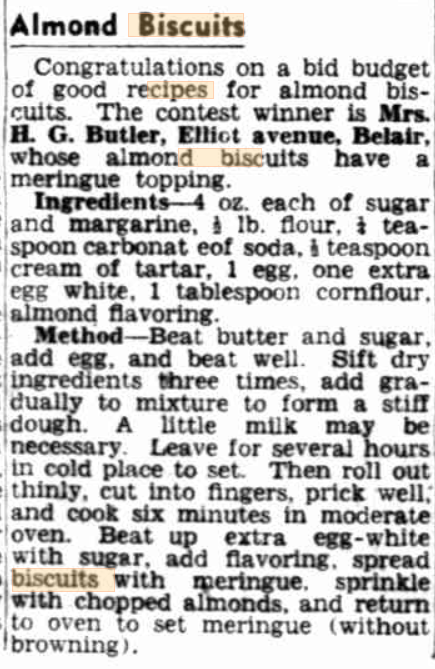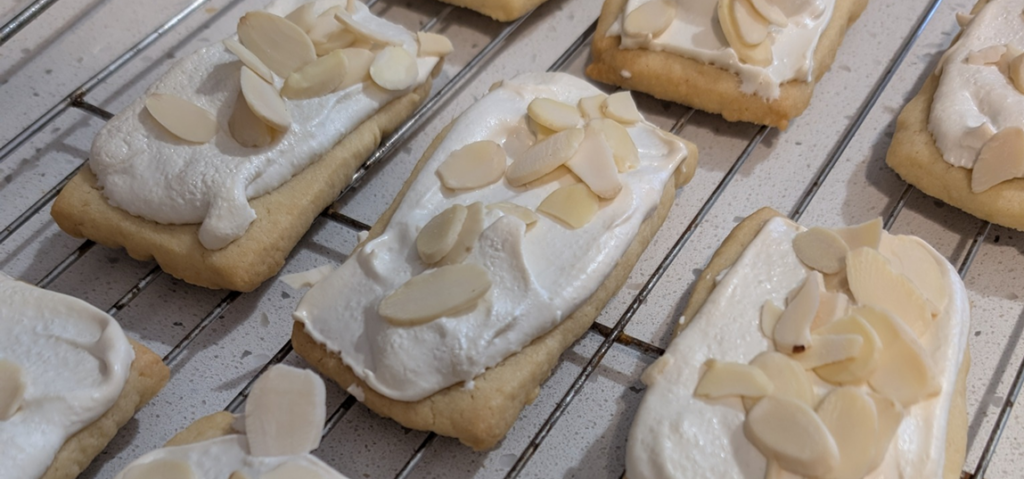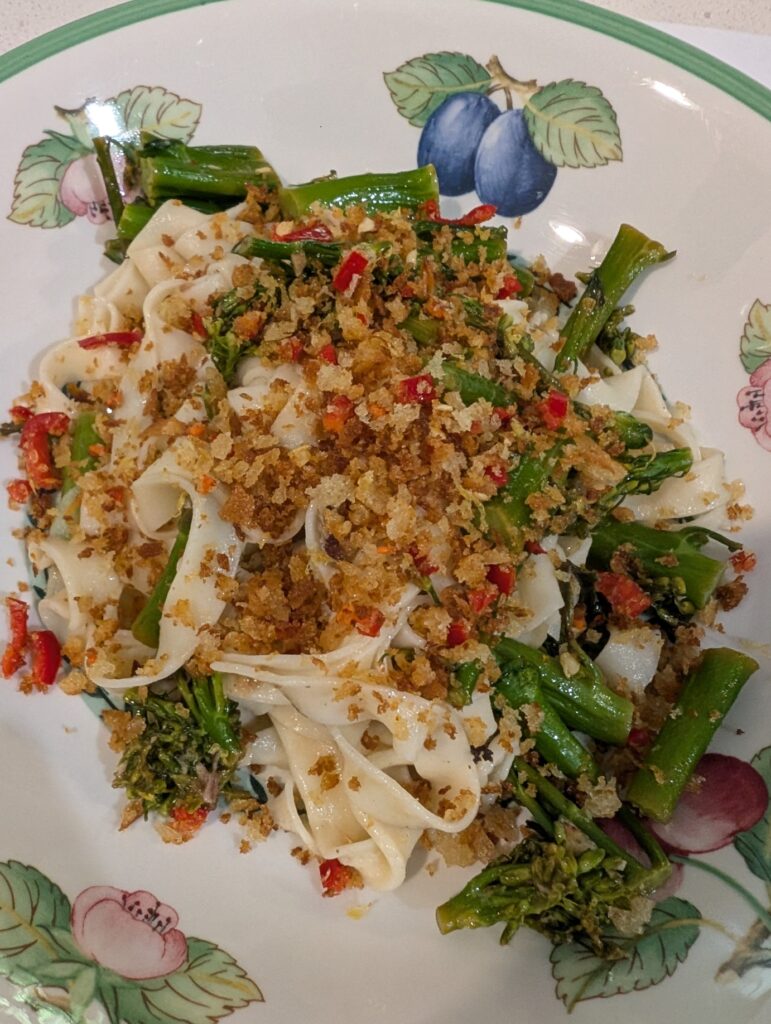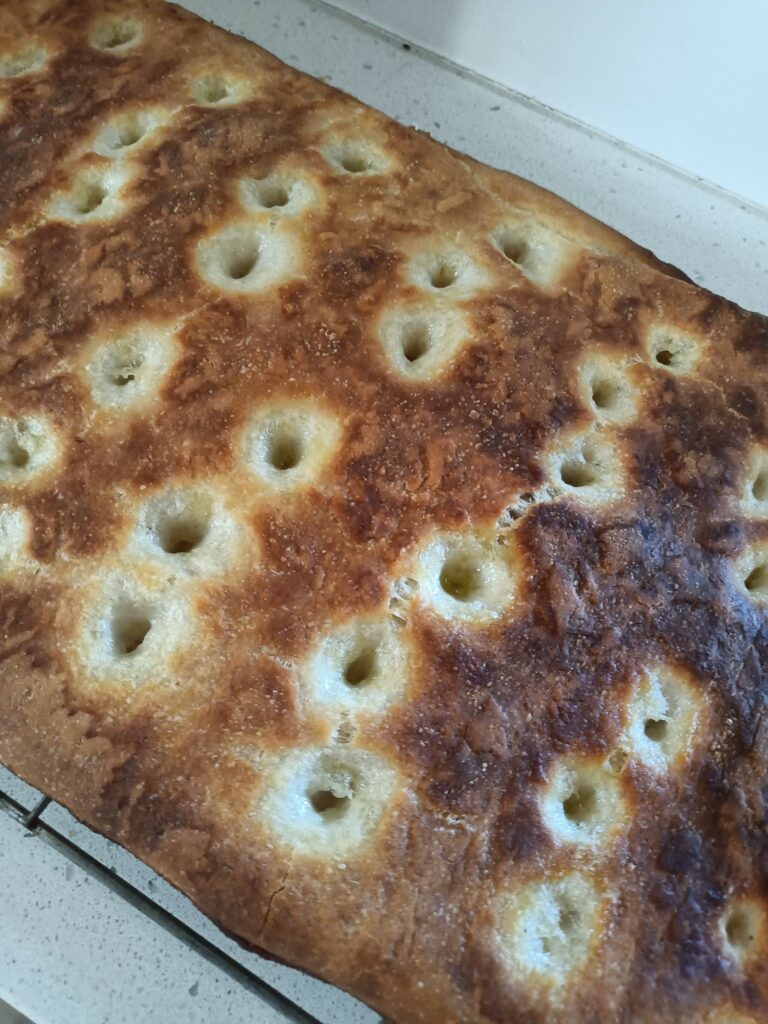This recipe, found on trove, is a 1947 offering from a Mrs HG Butler of Elliot Avenue, Belair*. It was published in the News on 21 Oct 1947 in the Lend-a-Hand Club section. Apparently a shout-out had been made for almond biscuits and this recipe was deemed the winner.
These are something a little different, as the biscuits have a meringue topping. I was sceptical about how well these might keep but it turns out they keep extremely well – although it was only tested for a couple of days in our house … I liked that the biscuits themselves weren’t too sweet and don’t worry about the apparent plainness of the biscuit, because the topping more than compensates.
Being the 1940s, Mrs Butler naturally uses imperial (gasp!) measures and her recipe writing assumes more about the reader than a modern recipe. To that end, I noted what I did so that I can provide you with a more approachable (I hope!) recipe. These are definitely worth a try and, of course, you could top with any nut of your choosing – whether chopped or flaked (l used flaked almonds as I had some).
The cornflour in the meringue was a new one for me (not for the whole rest of the internet apparently) – it helps stabilise the meringue. If you are using the meringue straight away there may be little point.
Ingredients
- 110g caster sugar
- 110g unsalted butter
- 220g plain flour
- 1/4 tsp bicarb
- 1/2 tsp cream of tartar
- 1 egg
- 2 tbsp milk
- 1 extra egg white
- 55g caster sugar
- 1 tbsp cornflour
- almond essence/flavouring
- flaked almonds or chopped/flaked nut of your choice
Directions
- Cream butter and sugar. This is beating them together to a smooth paste.
- Sift the flour, bicarb and cream of tartar. If you are making this all by hand, then sift 3x, but if you’re using a stand mixer or food processor you can get away with one sift (or, indeed, one).
- Beat the dry ingredients with the creamed butter and sugar and add the egg.
- If the mixture is very stiff, add the milk as needed. The dough should be quite firm though.
- Wrap the dough in floured cling film and put in the fridge for at least half an hour. You need to tread the fine ground between chilling so the biscuits are easy to cut and not over chilling so the dough is difficult to roll out. A good alternative is to roll into a cylinder as you can then slice off biscuits.
- Preheat oven to 160C fan bake. Line a baking tray with baking paper.
- Once the dough is chilled, roll out thinly and cut into biscuits. I cut into roughly 8cm x 5cm biscuits and it made 15. You do want the biscuits to be quite thin.
- Bake the biscuits for 10-15 minutes. Keep an eye on them – you don’t want them to burn and you need to accept some wriggle room here based on how thinly you’ve rolled them and your oven’s idiosyncrasies.
- While the biscuits are baking, make the meringue. Whisk the egg white to soft peaks and then slowly whisk in the caster sugar, 1 tbsp at a time, ensuring it is well combined before adding the next. The mixture should be stiff and glossy. Add the cornflour (still whisking) and a little almond extract – no more than a splash! (Almond extract is super potent – so we are literally talking 1/4 tsp no more, otherwise your meringue will taste like marzipan.
- Turn the oven down to 120C.
- Spread the meringue on the cooled biscuits and top with the nuts and return to the oven to set the meringue. This may take up to 15 minutes and again, depending on your oven, you might want to keep an eye on things as you don’t want the meringue to pick up much/if any colour.
* If you’re interested, a search of trove for butler “elliot avenue” belair shows that Mr & Mrs HG Butler were married in in 1921 in the Glanville Methodist Church.




